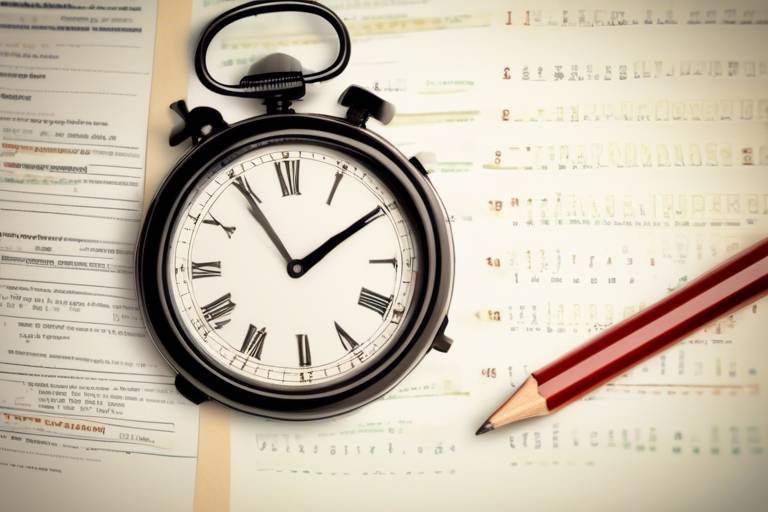Using a Time Audit to Improve Productivity
Are you constantly feeling like there are not enough hours in the day to get everything done? Do you find yourself overwhelmed with tasks and struggling to stay focused? It might be time to consider conducting a time audit to improve your productivity. By taking a closer look at how you spend your time, you can identify inefficiencies, prioritize tasks effectively, and ultimately make the most out of your day.

Understanding Time Audit
Learn how conducting a time audit can help you identify time-wasting activities, prioritize tasks efficiently, and boost overall productivity in your personal and professional life.
Discover what a time audit is and how it involves tracking and analyzing how you spend your time to make informed decisions on optimizing your daily routines and tasks.
Explore the various advantages of implementing a time audit, such as increased awareness of time usage, improved time management skills, and enhanced productivity and focus.
Find out how a time audit can reveal common time-wasting activities like excessive social media use, unnecessary meetings, or multitasking, allowing you to eliminate or minimize them effectively.
Learn how conducting a time audit can help you identify your most important tasks and allocate time and energy to them, leading to better time allocation and increased productivity.
Get practical tips on how to start and maintain a time audit, including choosing the right tools, setting goals, tracking your activities, and analyzing the results for actionable insights.
Discover the importance of establishing a consistent time audit schedule, whether daily, weekly, or monthly, to track your progress, identify patterns, and make necessary adjustments.
Explore advanced time management techniques that can be derived from the insights gained through a time audit, such as time blocking, batching similar tasks, and setting boundaries to enhance productivity.
Understand the significance of regularly reviewing and refining your time audit process to adapt to changing priorities, habits, and goals, ensuring sustained productivity gains in the long run.

Benefits of Time Auditing
When it comes to improving productivity, conducting a time audit can be a game-changer. By taking a closer look at how you spend your time, you can uncover valuable insights that can help you make better decisions and optimize your daily routines. But what exactly are the benefits of time auditing?
One of the key advantages of implementing a time audit is the increased awareness it brings to your time usage. By tracking and analyzing your activities, you gain a clearer understanding of where your time is being spent. This heightened awareness allows you to identify inefficiencies and time-wasting habits that may be hindering your productivity.
Moreover, time auditing can significantly improve your time management skills. By carefully examining how you allocate your time, you can learn to prioritize tasks more effectively. This skill is crucial in ensuring that you focus on the most important activities that align with your goals, ultimately leading to enhanced productivity and increased focus.
Additionally, time auditing empowers you to identify and eliminate common time wasters. Whether it's spending too much time on social media, attending unnecessary meetings, or trying to multitask, a time audit can pinpoint these unproductive habits. Once identified, you can take proactive steps to minimize or eliminate these time-wasting activities, allowing you to reclaim valuable time for more meaningful tasks.

Identifying Time Wasters
When it comes to identifying time wasters, a time audit can be a powerful tool to unveil the activities that are consuming your precious time without providing much value in return. By tracking and analyzing your daily routines and tasks, you can pinpoint the culprits that are hindering your productivity and focus. Common time wasters often include activities like scrolling through social media aimlessly, attending unnecessary meetings that could have been emails, or attempting to multitask and ending up getting less done.
Imagine each time-wasting activity as a leak in a bucket that is draining your time and energy. The more leaks you have, the less efficient and productive you become. By conducting a thorough time audit, you can patch up these leaks and ensure that your time is spent on activities that align with your goals and priorities. It's like decluttering your schedule to make room for what truly matters.

Setting Priorities
Setting priorities is a crucial aspect of effective time management. By conducting a time audit, you can pinpoint your most important tasks and allocate your time and energy accordingly. This process enables you to focus on high-value activities that align with your goals and objectives, leading to increased productivity and efficiency.

Implementing a Time Audit
Implementing a time audit is a crucial step towards improving your productivity and efficiency. By tracking and analyzing how you spend your time, you can gain valuable insights that will help you make informed decisions on how to optimize your daily routines and tasks.
When starting a time audit, it's essential to choose the right tools that suit your preferences and needs. Whether you prefer using digital apps, spreadsheets, or traditional pen and paper, the key is to find a method that works best for you.
Setting clear goals for your time audit is also important. Define what you aim to achieve through this process, whether it's identifying time-wasting activities, improving time management skills, or increasing overall productivity.
Tracking your activities diligently is the cornerstone of a successful time audit. Make sure to record how you spend each minute of your day accurately, including work tasks, breaks, leisure activities, and any distractions that may arise.
Once you have gathered sufficient data, it's time to analyze the results for actionable insights. Look for patterns, identify areas where time is being wasted, and pinpoint tasks that require more focus and attention.
Remember that implementing a time audit is not a one-time task but an ongoing process. Regularly review and adjust your time audit schedule, refine your tracking methods, and adapt to changing circumstances to ensure continuous improvement in your time management skills and productivity levels.

Creating a Time Audit Schedule
When it comes to , consistency is key. By establishing a regular routine for tracking and analyzing your time usage, you can gain valuable insights into your productivity patterns and make informed decisions on how to optimize your daily schedule. Whether you choose to conduct a time audit on a daily, weekly, or monthly basis, the important thing is to stick to your schedule and make it a habit.
Think of your time audit schedule as a roadmap that guides you through your day, helping you stay on track and focused on your priorities. Just like how a chef follows a recipe to create a delicious dish, you can follow your time audit schedule to ensure that you are making the most of your time and energy. It's all about creating a framework that works for you and allows you to maximize your productivity.
Consider using time blocking techniques to allocate specific time slots for different tasks or activities within your schedule. This method can help you create a clear structure for your day and prevent distractions from derailing your focus. By setting boundaries around your time and dedicating blocks of time to specific tasks, you can increase your efficiency and accomplish more in less time.
Another strategy to consider when is to batch similar tasks together. Instead of jumping back and forth between different types of activities, try grouping similar tasks that require similar mental energy or resources. This approach can help you streamline your workflow, minimize context switching, and improve your overall productivity.
Remember, the goal of is not just to track your time but also to optimize it for maximum efficiency and effectiveness. By setting aside dedicated time to review and analyze your time audit data, you can identify areas for improvement, adjust your schedule as needed, and continuously fine-tune your time management strategies for better results.

Optimizing Time Management Strategies
Optimizing Time Management Strategies involves delving deeper into the insights gained from conducting a time audit to refine and enhance your productivity techniques. By identifying patterns and trends in how you spend your time, you can tailor your approach to time management for maximum efficiency. One effective strategy that can be derived from a time audit is time blocking, where you allocate specific time blocks for different tasks or activities, ensuring focused attention and minimizing distractions. Additionally, batching similar tasks together can streamline your workflow and reduce transition time between different types of work. Setting boundaries around your time and availability can also help in optimizing your productivity by preventing interruptions and allowing for dedicated focus periods.

Continuous Improvement
Continuous improvement is the key to long-term success in any endeavor. By regularly reviewing and refining your time audit process, you can adapt to changing priorities, habits, and goals, ensuring sustained productivity gains over time. This iterative approach allows you to fine-tune your time management strategies, making them more effective and efficient.
Think of continuous improvement as a journey rather than a destination. Just like a sculptor who continuously refines a piece of art to achieve perfection, you too can refine your time management skills through ongoing assessment and adjustment. Each iteration of your time audit brings you closer to optimal productivity and efficiency.
One way to facilitate continuous improvement is to set specific goals based on the insights gained from previous time audits. By identifying areas for enhancement and establishing measurable objectives, you can track your progress and celebrate small victories along the way. This proactive approach keeps you motivated and focused on constant growth.
Moreover, involving others in your continuous improvement process can provide valuable perspectives and feedback. Collaborating with colleagues, mentors, or friends can offer fresh insights and innovative ideas for optimizing your time management practices. Embrace feedback as a catalyst for improvement and leverage diverse viewpoints to refine your strategies.
Remember, continuous improvement is not about perfection but progress. Embrace the journey of self-improvement, celebrate your successes, learn from setbacks, and keep striving for excellence. With each cycle of improvement, you become more adept at maximizing your time, energy, and resources, ultimately achieving your personal and professional goals with greater efficiency and effectiveness.
Frequently Asked Questions
- What is a time audit?
A time audit is a process of tracking and analyzing how you spend your time to gain insights into your daily activities and identify areas where you can improve efficiency and productivity.
- How can a time audit benefit me?
Implementing a time audit can help you become more aware of how you use your time, improve your time management skills, prioritize tasks effectively, and ultimately boost your productivity and focus.
- What are some common time-wasting activities that a time audit can reveal?
A time audit can uncover activities such as excessive social media use, attending unnecessary meetings, multitasking, or engaging in unproductive tasks, allowing you to eliminate or reduce these time wasters.
- How do I start implementing a time audit?
To begin a time audit, choose suitable tracking tools, set clear goals, monitor your activities diligently, and analyze the collected data to make informed decisions on optimizing your time management strategies.
- What are some advanced time management techniques that can be derived from a time audit?
Insights gained from a time audit can lead to strategies like time blocking, grouping similar tasks together, and establishing boundaries to enhance your efficiency and productivity in managing tasks.
- Why is continuous improvement important in the time audit process?
Regularly reviewing and refining your time audit process allows you to adapt to changing circumstances, habits, and goals, ensuring that you continue to make progress and achieve sustained productivity gains over time.

















